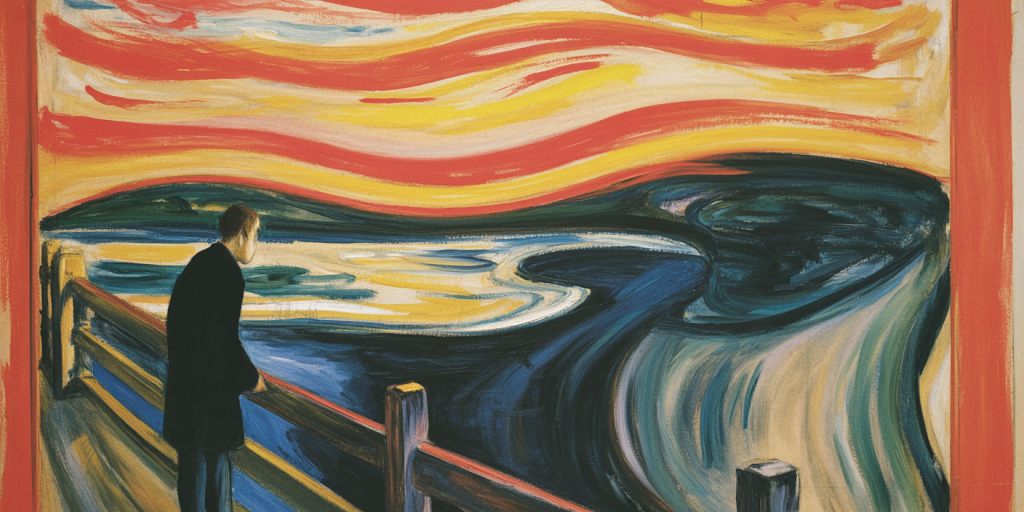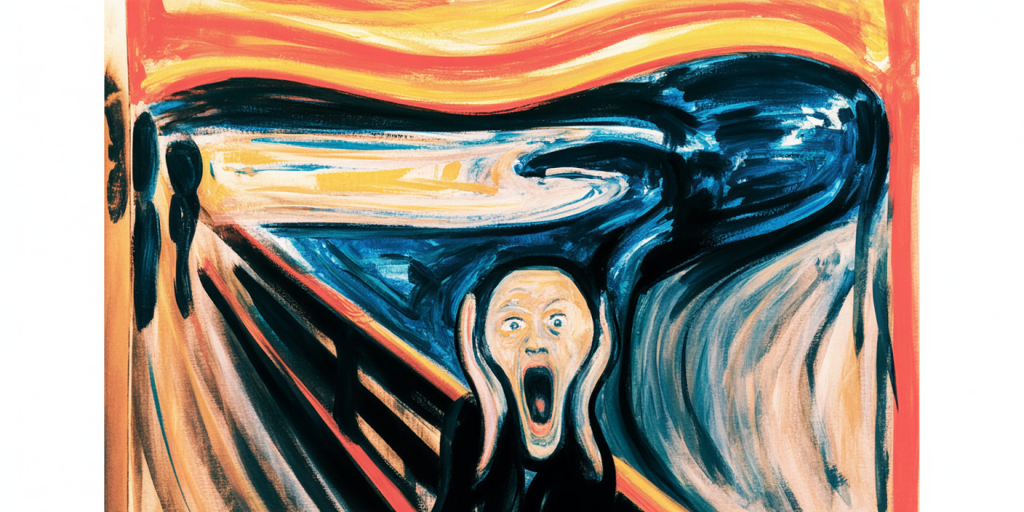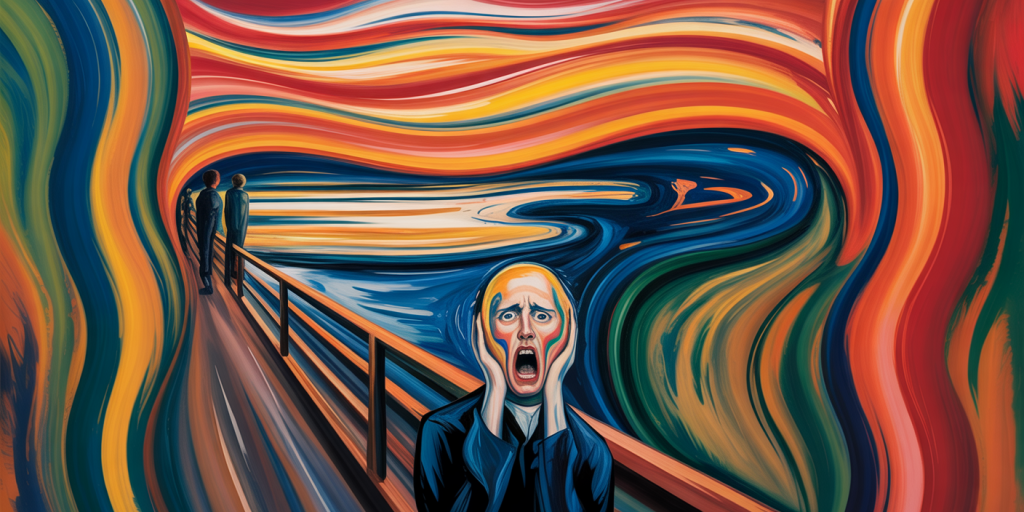The Scream of Munch Still Echoes in the Mountains of the Unconscious
There are voices that do not end when the mouth closes. Some screams outlive the lungs that birthed them. They cling to landscapes, melt into skies, and become part of the wind. In Edvard Munch’s The Scream, the cry is not just from the figure—it is the very air that trembles. The canvas itself inhales that primal terror and exhales it endlessly. What we hear is not the scream of one man, but the echo of humanity’s fracture reverberating through the mountains of the unconscious.
To gaze upon The Scream is not merely to look at a painting, but to fall into an emotional tremor. The figure’s agony is not depicted—it is enacted, reverberated through every brushstroke, every wave of blood-orange sky, every trembling line that warps the landscape like a psychic fault line. This is not art as representation. It is art as rupture, as confession, as existential vibration.
Table of Contents
- The Cry That Paints the Sky
- A Landscape of Internal Collapse
- Color as Psychic Frequency
- The Hollow Figure That Holds Us
- The Bridge as Threshold
- Vibrations of Dread
- When Silence Begins to Howl
- The Red Horizon of Panic
- The Curvature of Fear
- Stillness in the Observers Behind
- Flesh That Melts into Atmosphere
- The Eyes That Refuse to See
- Echoes Painted in Swirls
- When the Air Becomes a Mirror
- Munch’s Pulse Within the Canvas
- A Frame That Breathes
- The Sound of Unbeing
- A Face Without Anchors
- Where Thought and Earthquake Meet
- The Art of Internal Earthquakes
The Cry That Paints the Sky
The sky in The Scream is not a backdrop—it is the voice itself. It burns in striations of crimson and ochre, like fire stitched into dusk. The colors do not stay contained in heaven; they descend and press against the figure, becoming both atmosphere and anguish. This is not merely a sunset—it is a psychological detonation.
A Landscape of Internal Collapse
The hills twist, the water ripples without calm, the lines betray topography. Nature has become the echo of an internal quake. The landscape follows no logic of geography, but of dread. The earth does not support—it wavers. It vibrates like a chest holding in a scream.

Color as Psychic Frequency
Each hue in The Scream operates not as description but as vibration. Orange bleeds with tension. Blue churns with unease. Black carves a wound through the canvas. These are not colors of the world but of the mind unraveling. They scream in frequencies we cannot hear but feel.
The Hollow Figure That Holds Us
The central figure is less a person and more an aperture. A mouth, open and infinite. Hands, clutching the sides of a head as if to contain implosion. The body, skeletal and melting, becomes not self but symptom. It holds all who look at it, drawing our anxiety into its void.
The Bridge as Threshold
The bridge is both physical and metaphysical. It separates and connects. On one side: the figure, absorbed in collapse. On the other: distant forms, walking away, untouched. The bridge marks the line between the visible scream and the quiet ones we carry.
Vibrations of Dread
Nothing in the painting is still. The lines quiver. The colors pulse. The sky roars. Dread is not shown but enacted. The entire scene vibrates like the throat of the terrified. You do not observe The Scream. You vibrate with it.
When Silence Begins to Howl
Though sound cannot be painted, Munch does something else. He shows its residue. The aftermath of noise. The way air curls when it is filled with terror. The scream exists not in the mouth, but in the warping world around it.
The Red Horizon of Panic
That line where the sun should set is instead where the mind begins to burn. Red streaks across the canvas like panic spreading across consciousness. It is not a color of beauty here—it is a warning. A flare of existential emergency.
The Curvature of Fear
Lines that should be straight bend with nervous curvature. The boardwalk, the railing, the water, the distant hills—all tremble under the pressure of psychic collapse. Perspective gives way to panic. Architecture becomes emotional topography.

Stillness in the Observers Behind
Two shadowed figures stand further along the bridge, calm, even detached. Their stillness is not comfort—it is estrangement. They do not hear the scream, or perhaps they choose not to. Their presence marks the isolation of terror: to suffer loudly in a world that looks away.
Flesh That Melts into Atmosphere
The figure’s edges blur, dissolve, become indistinct. Skin bleeds into air. Form collapses into ether. Identity disintegrates. This is not mere physicality—this is the psyche unraveling, the boundary between self and terror erased.
The Eyes That Refuse to See
The eyes are wide, but what do they see? There is no gaze, only the presence of fear. They are voids, not viewers. They reflect the viewer back to themselves—to the fears they do not name, to the emptiness they hide in the mirror.
Echoes Painted in Swirls
The swirling brushstrokes carry the resonance of the scream across the canvas. Like ripples from a thrown stone, the cry travels outward. Every line curves in response, as if sound could bend wood, sky, perception.
When the Air Becomes a Mirror
The sky does not hang above—it reflects inward. It mimics not weather, but mood. Air becomes mirror, and the world reflects the internal storm. Nature is not outside us in Munch’s world. It is shaped by the anguish within.
Munch’s Pulse Within the Canvas
One feels Munch’s own heartbeat in the painting’s rhythm. His brush does not glide; it trembles. Each stroke a pulse. Each color a breath. The painting does not show pain—it contains the tempo of it. Munch becomes the landscape.
A Frame That Breathes
Even the boundaries of the painting feel porous. The scream does not stop at the canvas edge. It leaks. It breathes into the room. The frame becomes lungs. The painting, an organ. The scream, a respiration shared.
The Sound of Unbeing
There is no language for the sound here. It is not a word but a wail. Not a message but a force. It is the sound of unbeing, of identity fraying, of the ego dissolving in panic. It is the pre-verbal howl of a mind undone.
A Face Without Anchors
The figure’s head lacks hair, structure, gender. It is human, and it is not. It is universal. An archetype. A soul in collapse. Without anchors, it floats in its own scream. It becomes every face that has ever crumbled silently.
Where Thought and Earthquake Meet
What Munch painted was not a landscape. It was the fault line where thought and tremor meet. The earthquake of consciousness. A rift not in land but in self. The Scream is the map of the fracture we try to cover.

The Art of Internal Earthquakes
Munch gave form to something most cannot articulate: the internal quake. The moment when emotion overtakes language. When the soul shakes in silence. He painted the invisible tremor. And we feel it, centuries later, each time we see that open mouth in a melting world.
FAQ
Who was Edvard Munch?
A Norwegian painter and printmaker (1863–1944), Munch was a pioneer of Expressionism. His art often explored themes of anxiety, mortality, and emotional intensity.
What inspired The Scream?
Munch described walking at sunset when the sky turned blood red and he felt “a vast, infinite scream through nature.” This moment became the seed of the painting.
What is the style of The Scream?
The Scream is a landmark of Expressionism, emphasizing internal emotion over external realism. It uses distortion, bold color, and rhythmic brushstrokes to convey psychological states.
What mediums did Munch use?
Munch created several versions of The Scream using oil, tempera, pastel, and lithography. Each medium amplified different emotional qualities.
Why is the painting so iconic?
The Scream taps into universal human emotion. Its open-mouthed figure and surreal landscape evoke existential dread in a way that transcends time and culture.
Final Reflections: When the Sky Still Trembles
The Scream does not age. It does not fade. Because it was never a moment—it was an echo. A vibration captured in color and line, still rippling through our collective unconscious. Munch did not paint an individual. He painted a fracture. A breath caught in terror. A world bending under the weight of inner storm.
And so, the scream goes on. Across museum walls. In the hush of anxious hearts. In the tremble of sunset skies. It is not just remembered—it is relived. Because somewhere, always, the mountains of the unconscious are still listening. Still echoing. Still screaming.
